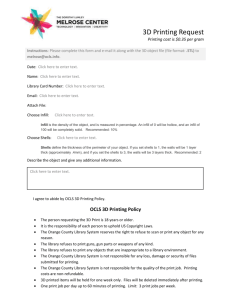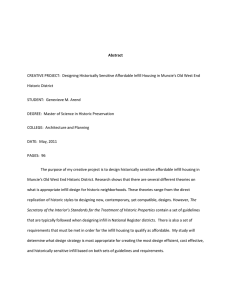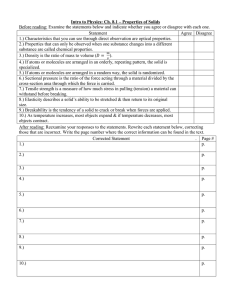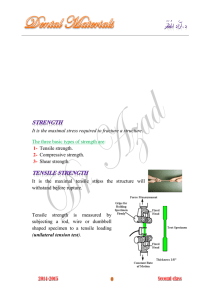3D Printed PLA Tensile Properties: Infill Pattern & Density Effects
advertisement
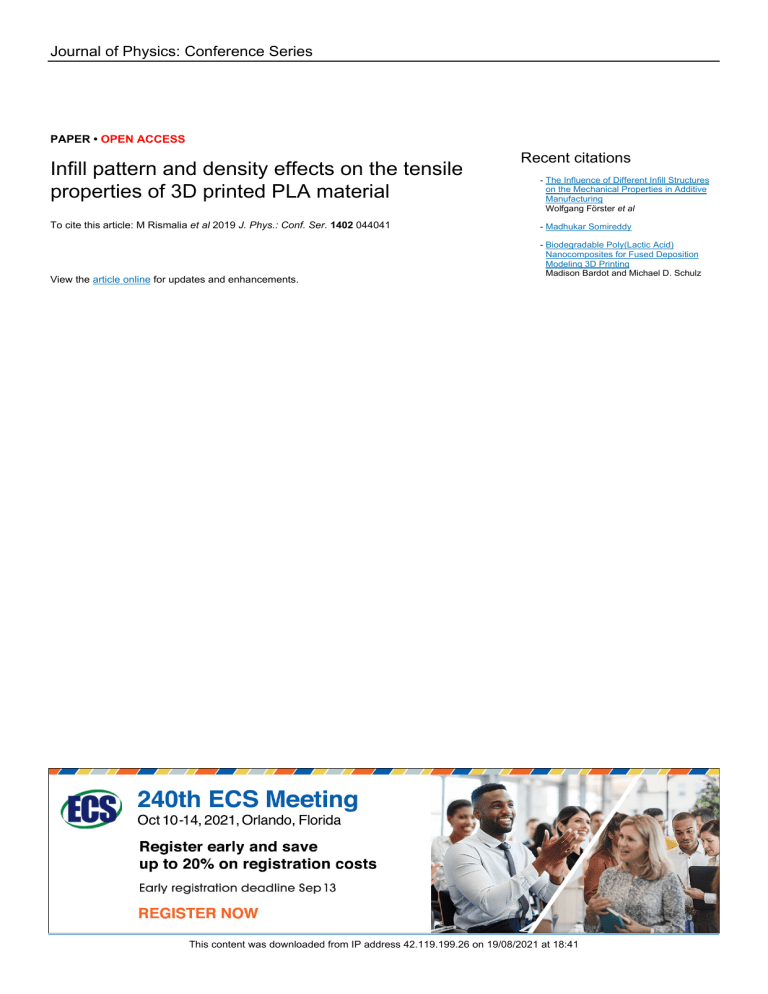
Journal of Physics: Conference Series PAPER • OPEN ACCESS Infill pattern and density effects on the tensile properties of 3D printed PLA material To cite this article: M Rismalia et al 2019 J. Phys.: Conf. Ser. 1402 044041 View the article online for updates and enhancements. Recent citations - The Influence of Different Infill Structures on the Mechanical Properties in Additive Manufacturing Wolfgang Förster et al - Madhukar Somireddy - Biodegradable Poly(Lactic Acid) Nanocomposites for Fused Deposition Modeling 3D Printing Madison Bardot and Michael D. Schulz This content was downloaded from IP address 42.119.199.26 on 19/08/2021 at 18:41 4th Annual Applied Science and Engineering Conference Journal of Physics: Conference Series 1402 (2019) 044041 IOP Publishing doi:10.1088/1742-6596/1402/4/044041 Infill pattern and density effects on the tensile properties of 3D printed PLA material M Rismalia1, S C Hidajat1, I G R Permana1, B Hadisujoto1, M Muslimin2 and F Triawan1,* 1 Department of Mechanical Engineering, Faculty of Engineering and Technology, Sampoerna University, Jakarta, Indonesia 2 Department of Mechanical Engineering, Politeknik Negeri Jakarta, Depok, Indonesia *farid.triawan@sampoernauniversity.ac.id Abstract. Additive manufacturing such as 3D printing is considered as a highly convenient manufacturing process since it enables to create any 3D objects. It is known that different materials, printing techniques, and printing parameters are affecting the mechanical properties of the printed objects. However, studies on the mechanical properties of the 3D printed structure are still limited. In this work, investigation of the relationship between two printing parameters, i.e. infill pattern and infill density were conducted on the Polylactic Acid (PLA) material. Three infill densities, 25%, 50%, and 75%, and three infill patterns, grid, tri-hexagon, and concentric, were chosen. The tensile test, ASTM D638, was employed to obtain the material properties based on these two printing parameters. An open-source 3D printing slicer software, Cura, was used to manufacture the tensile specimens. The Young’s modulus, yield strength, and ultimate strength were recorded and examined. The results showed that the tensile properties increase as infill density increases. Of the three-printing pattern, the concentric has the highest values of tensile properties regardless of the infill densities. This finding can be used as a reference for creating a finite element model (FEM) as well as predicting the optimum tensile properties with respect to the printing parameters. 1. Introduction Three-Dimensional (3D) Printing is one of the additive manufacturing methods. It performs rapid prototyping (RP) using a Computer-Aided Design (CAD). It is a manufacturing method that builds 3D objects by printing, i.e. melting and solidifying, the material layer by layer. The system consists of a frame, stepper motors, extruder with hot-end nozzle, a computer, and a microcontroller. The microcontroller, such as Arduino utilizing an open-source software [1], controls the movement of the extruder through stepper motors in X, Y, Z directions. Nowadays, the technology of 3D printing is becoming more affordable [2] and considered as highly promising for the future manufacturing industries [3] and higher education purposes [4]. The materials commonly used in non-metallic 3D printing are thermoplastics such as Acrylonitrile Butadiene Styrene (ABS) and Polylactic Acid (PLA) [5]. Based on literatures, PLA is mostly used because of its affordability, availability, and its weightlessness. Additionally, the mechanical properties of the 3D printed PLA are higher than that of the ABS [6]. Considering limited research and experiment data in the literature on the mechanical properties of the 3D printed PLA material, this study focused on the relationship between two printing parameters, Content from this work may be used under the terms of the Creative Commons Attribution 3.0 licence. Any further distribution of this work must maintain attribution to the author(s) and the title of the work, journal citation and DOI. Published under licence by IOP Publishing Ltd 1 4th Annual Applied Science and Engineering Conference Journal of Physics: Conference Series 1402 (2019) 044041 IOP Publishing doi:10.1088/1742-6596/1402/4/044041 infill density and infill pattern. Tensile tests based on ASTM D638 were conducted to obtain the material properties based on these printing parameters. An open-source 3D printing slicer software, Cura, was used to vary the printing parameters. The tensile properties, i.e. Young’s modulus, yield strength, and ultimate strength were presented and discussed. 2. Research methodology 2.1. Specimen fabrication Three infill densities, 25%, 50%, and 75%, and three infill patterns, grid, tri-hexagon, and concentric, were chosen. Hence, nine combinations of the printing parameters were set. Following the ASTM standard, five test specimens were manufactured for each combination, totaling of forty-five manufactured specimens to be tested. The specimens were printed using Anycubic i3 Mega extruder. The material, 1.75 mm PLA filament, with printing melting temperature around 190°C - 230°C. The specimen printing temperature was set at 210°C. The dimension of the specimens was according to ASTM D638-Type I standard, shown in figure 1 below. The software used for controlling the printing parameters was the open-source slicer software, Cura. Figure 1. The dimension of ASTM D638 – type I test specimen in mm. (d) (a) (b) (e) (c) (f) Figure 2. Infill patterns: (a) grid, (b) tri-hexagonal, and (c) concentric. Grid pattern infill densities: (d) 25%, (e) 50%, and (f) 75%. The three infill patterns shown in figure 2 are (a) grid, (b) tri-hexagonal, and (c) concentric. The grid pattern prints the object layer in 90 degrees crossing paths, where the paths make 45 degrees angle with respect to the axial axis of the specimen. The tri-hexagonal pattern prints the object layer in three different path directions, differed by 120 degrees rotation from one path to another. The lowest path angle with respect to the specimen axial axis is 30 degrees. The concentric pattern prints in the direction of the specimen axial axis. Subfigures (d), (e), and (f), in figure 2 represent the grid pattern increasing infill density of 25%, 50%, and 75%, respectively. The printing parameters are listed in table 1. 2 4th Annual Applied Science and Engineering Conference Journal of Physics: Conference Series 1402 (2019) 044041 IOP Publishing doi:10.1088/1742-6596/1402/4/044041 Table 1. Printing parameter constants of test specimens. Parameters Layer Height Horizontal Shell: a solid layer top and bottom Wall Thickness Top/Bottom Thickness Printing Temperature Build Plate Temperature Printing Speed Values 0.1 mm 3 layers 1.2 mm 0.6 mm 210o C 70o C 50 mm/s 2.2. Tensile test The ASTM D638 “Standard Test Methods for Tensile Properties of Plastics” [7] was applied to test the specimens. The tensile tests were conducted using the Universal Testing Machine, Test Resource 313. The crosshead testing rate (i.e. constant speed tensile test) was set at 5 mm/min. The output of the tensile tests was recorded as the uniaxial tensile load versus the elongation (changes in length), which were then transformed into engineering stress and strain curves. The engineering stress was calculated by dividing the load with the initial cross-sectional area of the specimen. In this experiment, it was found that the engineering strain obtained from the machine was less accurate. Therefore, strain gauges were used to obtain a more accurate one [8]. A strain gauge was attached to the center of the specimen to measure the axial deformation, as illustrated in figure 3. The strain measurements were recorded using the National Instruments data acquisition system, NI-9265, along with the LabView software. Figure 3. The strain gauge attached to the specimen in the tensile machine and connected to the data acquisition system. The tensile properties, such as Young’s modulus, yield strength, and ultimate strength were then calculated. The yield strength was obtained by constructing a tangent line from the offset strain of 0.2%; the extended tangent line that intersects the stress-strain curve is the approximation for yield point. The ∆𝜎 Young’s modulus was obtained by evaluating the value of stress with respect to strain, [10, 11] which ∆𝜀 represents the gradient of the stress-strain curve at the elastic region [12]. The ultimate strength was obtained by taking the highest peak of the curve. 3 4th Annual Applied Science and Engineering Conference Journal of Physics: Conference Series 1402 (2019) 044041 IOP Publishing doi:10.1088/1742-6596/1402/4/044041 3. Results and discussion The test results of the nine combinations are summarized in table 2 and plotted in figure 4. The values shown are Young’s modulus, yield strength, and ultimate strength which were extracted from the average measurement values of each combination of the five specimens tested according to the ASTM standard. Table 2. Tensile properties of the PLA Specimens. 1 2 3 4 5 6 7 8 9 Infill Pattern Infill Density Young’s Modulus (GPa) Yield Strength (MPa) Grid Grid Grid Tri-hexagonal Tri-hexagonal Tri-hexagonal Concentric Concentric Concentric 25 % 50 % 75 % 25 % 50 % 75% 25 % 50 % 75% 2.76 ± 0.38 2.8 ± 0.12 3.28 ± 0.17 2.61 ± 0.21 2.72 ± 0.14 3.01 ± 0.21 3.14 ± 0.19 3.27 ± 0.11 3.897 ± 0.37 28.1 ± 0.23 29.6 ± 0.78 33.3 ± 1.33 25.5 ± 2.13 27.6 ± 1.11 35.9 ± 0.59 33.7 ± 2.12 40.3 ± 0.26 40.98 ± 0.84 Ultimate Strength (MPa) 29.7 ± 1.29 31.5 ± 2.17 35.4 ± 0.46 27.8 ± 0.94 30.6 ± 1.23 37.3 ± 1.11 32.6 ± 0.71 44.3 ± 2.94 42.2 ± 2.47 Figure 4. The tensile properties values with respect to the various infill densities and infill patterns: (a) Young’s modulus, and (b) yield strength, (c) ultimate strength. 4 4th Annual Applied Science and Engineering Conference Journal of Physics: Conference Series 1402 (2019) 044041 IOP Publishing doi:10.1088/1742-6596/1402/4/044041 Figure 5. Stress-strain plots: (a) grid pattern with varied infill densities, (b) 50% infill density with varied infill patterns. In general, the trend shows that the tensile properties are increasing as the infill density increases, except for the concentric pattern with 75% infill density, where the value of ultimate strength is decreasing from 44.3 MPa to 42.2 MPa. This trend is depicted in Figure 5(a), showing the grid with increasing infill densities of 25%, 50%, and 75%. Similar finding shows that higher infill density implies higher resistance to applied stress internally [9]. In addition, infill patterns have an effect on tensile properties. In Figure 5(b), for the infill density of 50%, the Young’s modulus of the grid pattern is similar to the tri-hexagonal pattern with an incrementally higher value. The concentric definitely has a much higher value than the other two. It can be hypothesized that the maximum values of the tensile properties are achieved by having the pattern path in the same direction as the tensile load direction. Based on the result, the highest tensile properties corresponded to concentric pattern with 75% of infill density, where it has 42.2 MPa of ultimate strength, 3.89 GPa of Young’s modulus, and 40.98 MPa of yield strength. In addition, grid pattern with 100% infill density was tested and it was recorded that the Young’s modulus and yield strength were 3.6 GPa and 48.2 MPa, respectively. For 100% infill density, the effect of infill pattern on mechanical properties is negligible [13]. 4. Conclusion The tensile properties of 3D printed PLA material with a combination of two printing parameters, infill density and infill pattern, were measured by tensile test experiment. In general, the results showed that increasing the infill density increases the tensile properties for the three infill patterns. Moreover, the infill patterns affect the tensile properties. Concentric infill pattern demonstrated the highest tensile properties compared with the other two while the grid and tri-hexagonal pattern are at similar levels. The results can be used as reference data for creating finite element model (FEM) and predicting the optimum tensile properties with respect to the selection of the printing parameters. Comprehensive investigation on the effect of infill pattern on the tensile properties is suggested for future study. Acknowledgments Authors would like to express gratitude and acknowledgement to Faculty of Engineering and Technology, Sampoerna University, for facilitating this research. 5 4th Annual Applied Science and Engineering Conference Journal of Physics: Conference Series 1402 (2019) 044041 IOP Publishing doi:10.1088/1742-6596/1402/4/044041 References [1] [2] [3] [4] [5] [6] [7] [8] [9] [10] [11] [12] [13] B Dong, G Qi, X Gu and X Wei 2008 Web service-oriented manufacturing resource applications for networked product development Advanced Engineering Informatics 22 282–95 T Letcher and M Waytashek 2014 Material Property Testing of 3D-Printed Specimen in PLA on an Entry-Level 3D Printer ASME 2014 International Mechanical Engineering Congress & Exposition 2A V02AT02A014 J Kentzer, B Koch, M Thiim, R W Jones and E Villumsen 2011 An Open Source Hardwarebased Mechatronics Project: The Replicating Rapid 3-D Printer 4th International Conference on Mechatronics (ICOM) F Triawan, M K Biddinika, S Hanaoka and B A Budiman 2019 Promoting Higher Education Abroad Program in Science and Engineering to Indonesian High Schools: Methods, Challenges and Recommendations Indonesian J. of Computing, Engineering and Design 1 17-28 X Tian, T Liu, C Yang, Q Wang and D Li 2016 Interface and performance of 3D printed continuous carbon fiber reinforced PLA composites Composites Part A: Applied Science and Manufacturing 88 198–205 B Tymrak, M Kreiger and J Pearce 2014 Mechanical properties of components fabricated with open-source 3-D printers under realistic environmental conditions Materials and Design 58 242–6 ASTM 2010 Standard test methods for tensile properties of plastics ASTM International in ASTM Standard D638 (West Conshohocken) K Hoffmann 1989 An Introduction to Measurements using Strain Gages (Alsbach, Darmstadt) X Zhou, S J Hsieh and C Ting 2018 Modelling and estimation of tensile behaviour of polylactic acid parts manufactured by fused deposition modelling using finite element analysis and knowledge-based library Virtual and Physical Prototyping 131 77-190 F Triawan, K Kishimoto, T Adachi, K Inaba, T Nakamura and T Hashimura 2012 The elastic behavior of aluminum alloy foam under uniaxial loading and bending conditions Acta Materialia 60 3084-93. F Triawan, T Adachi, K Kishimoto and T Hashimura 2010 Study on elastic moduli of aluminum alloy foam under uniaxial loading and flexural vibration J. of Solid Mechanics and Materials Engineering 4 1369-80. M Hibi, F Triawan, K Inaba, K Takahashi, K Kishimoto, K Hayabusa and H Nakamoto 2018 Cavitation damage of epoxy resin subjected to uniaxial tensile loading J. of Mechanical Engineering 5 17-00151 M F Vicente, W Calle, S Ferrandiz and Conejero 2016 A Effect of Infill Parameters on Tensile Mechanical Behavior in Desktop 3D Printing 3D Printing and Additive Manufacturing 3 183-92 6
